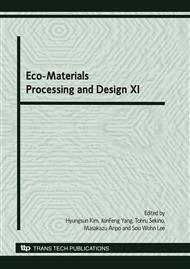p.85
p.89
p.93
p.97
p.101
p.105
p.109
p.113
p.117
Relation between Phosphorus Amounts Absorbed by Volcanic Ash Fall Deposits and its Calcinating Temperature
Abstract:
Phosphorus was one of the causative materials of eutrophication that was widely generated in the water system, for instance, the rivers, lakes, and marshes all over the world. The removal method using the phosphorus adsorption ability of volcanic ash fall deposits contained especially the amorphous alumino-silicate mineral was examined. To improve the practicality of durability and the adsorption ability of the volcanic ash fall deposits was heated within the range from 100 to 1100degrees. It was found that the phosphorus adsorption ability of the material was increased as the calcinating temperature was raised, and reached the maximum value at about 600degrees. The amount of adsorption of phosphorus had decreased rapidly when the material was heating to 600degrees or more.
Info:
Periodical:
Pages:
101-104
Citation:
Online since:
July 2010
Authors:
Keywords:
Price:
Сopyright:
© 2010 Trans Tech Publications Ltd. All Rights Reserved
Share:
Citation:


